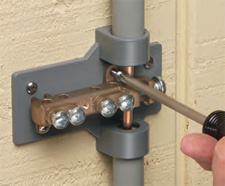
Bonding vs. Grounding: A Primer
Chuck Ross
Bonding and grounding are simple concepts, but, unfortunately, they’re also easily confused with each other. Definitions of one term often get wrapped up in the definitions of the other, and, before long, one can begin thinking the words are interchangeable.
“Grounding” refers to the creation of a path from electrical equipment to the earth. It is intended to protect equipment and help prevent fires that might occur due to high voltages resulting from lightning strikes, line surges or unintended contact with higher-voltage lines. To accomplish these goals, a grounding electrode conductor is used to connect the main panel to a grounding electrode buried into the earth.
It’s important to understand that, while grounding may help limit overcurrent damage, it won’t help in clearing a breaker or fuse. This task is accomplished through bonding. And this is where some confusion can come in – bonding’s goal is to create an effective ground-fault current path. So, yes, the “equipment grounding conductor” incorporated into MC and NM cable is actually there to ensure proper bonding.
Bonding is required to ensure a low-impedance fault-current path exists back to the source. This is the only way to be confident a breaker or fuse will respond properly in many ground-fault situations. In fact, all electrically conductive materials that could become energized – including metal water pipes, gas pipes and exposed structural-steel member – must be bonded to such an effective ground-fault current path. Without adequate bonding, these metal building materials could become electrified, creating a major safety hazard, without the fuse or breaker ever tripping.
“Grounding” refers to the creation of a path from electrical equipment to the earth. It is intended to protect equipment and help prevent fires that might occur due to high voltages resulting from lightning strikes, line surges or unintended contact with higher-voltage lines. To accomplish these goals, a grounding electrode conductor is used to connect the main panel to a grounding electrode buried into the earth.
It’s important to understand that, while grounding may help limit overcurrent damage, it won’t help in clearing a breaker or fuse. This task is accomplished through bonding. And this is where some confusion can come in – bonding’s goal is to create an effective ground-fault current path. So, yes, the “equipment grounding conductor” incorporated into MC and NM cable is actually there to ensure proper bonding.
Bonding is required to ensure a low-impedance fault-current path exists back to the source. This is the only way to be confident a breaker or fuse will respond properly in many ground-fault situations. In fact, all electrically conductive materials that could become energized – including metal water pipes, gas pipes and exposed structural-steel member – must be bonded to such an effective ground-fault current path. Without adequate bonding, these metal building materials could become electrified, creating a major safety hazard, without the fuse or breaker ever tripping.
Photo courtesy of Arlington Industries



